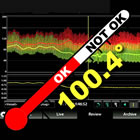
Dr. Andreas Gruentzig
“I don’t know how anyone can do these procedures without measuring pressures!”
That’s what Andreas Gruentzig, the father of coronary angioplasty, said to me back in 1985. He knew that looking at the angiogram alone was not sufficient for judging the blockage in an artery. Integral to the design of his technological breakthrough, the double-lumen angioplasty balloon, was a feature which allowed him to measure the blood pressure at either end of the arterial blockage. At the start of the procedure, he could quantify how significant the blockage was; when he was done inflating the balloon, he could see the benefit of the dilatation. The post-angiogram might look good, but the pressures sometimes signaled that blood flow through the area was not. So, inflate again. And maybe again. OK, pressure now looks good, we’re done! Pretty simple. Not brain surgery. Continue reading

 This week started off with me watching a demonstration of fractional flow reserve (FFR) during multivessel PCI. This very instructive case was transmitted live from Hammersmith Hospital in London and featured Dr. Justin E. Davies showing how to perform FFR and, more importantly, how the use of FFR changed the treatment plan for this patient.
This week started off with me watching a demonstration of fractional flow reserve (FFR) during multivessel PCI. This very instructive case was transmitted live from Hammersmith Hospital in London and featured Dr. Justin E. Davies showing how to perform FFR and, more importantly, how the use of FFR changed the treatment plan for this patient. The coronary angiogram is often referred to as a road map of the heart. As such, it serves the cardiologist and cardiac surgeon well. It shows where the coronary arteries are, how they intersect, the angles of the branches, etc. There are diagrams of these anatomical features in many textbooks, but the reality is that these characteristics can vary from individual to individual, so it’s necessary to get a road map for each individual in whom an intervention is being contemplated. Then, of course, there’s the issue of narrowings in the coronary arteries. Should these receive stents? Should they be bypassed? Should they be left alone and treated with medical therapy?
The coronary angiogram is often referred to as a road map of the heart. As such, it serves the cardiologist and cardiac surgeon well. It shows where the coronary arteries are, how they intersect, the angles of the branches, etc. There are diagrams of these anatomical features in many textbooks, but the reality is that these characteristics can vary from individual to individual, so it’s necessary to get a road map for each individual in whom an intervention is being contemplated. Then, of course, there’s the issue of narrowings in the coronary arteries. Should these receive stents? Should they be bypassed? Should they be left alone and treated with medical therapy? 

 Former President George W. Bush received an angioplasty and stent this morning at
Former President George W. Bush received an angioplasty and stent this morning at  Yesterday’s edition of USA Today carried an article by Peter Eisler titled, “
Yesterday’s edition of USA Today carried an article by Peter Eisler titled, “

